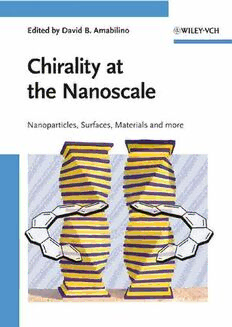
Chirality at the Nanoscale: Nanoparticles, Surfaces, Materials and more PDF
Preview Chirality at the Nanoscale: Nanoparticles, Surfaces, Materials and more
Chirality at the Nanoscale Edited by David B. Amabilino Further Reading Carreira, E.M., Kvaerno, L. Classics in Stereoselective Synthesis 2009 ISBN:978-3-527-32452-1 Amouri, H., Gruselle, M. Chirality in Transition Metal Chemistry Molecules,SupramolecularAssembliesandMaterials 2009 ISBN:978-0-470-06053-7 Ding, K./Uozumi,Y.(eds.) Handbook of Asymmetric Heterogeneous Catalysis 2008 ISBN-13:978-3-527-31913-8 Köhler, M.,Fritzsche, W. Nanotechnology AnIntroductiontoNanostructuringTechniques 2007 ISBN:978-3-527-31871-1 Wagnière, G. H. On Chirality and the Universal Asymmetry ReflectionsonImageandMirrorImage 2007 ISBN:978-3-906390-38-3 Samori,P.(ed.) Scanning Probe Microscopies Beyond Imaging ManipulationofMoleculesandNanostructures 2006 ISBN:978-3-527-31269-6 Chirality at the Nanoscale Nanoparticles, Surfaces, Materials and more Edited by David B. Amabilino TheEditor AllbookspublishedbyWiley-VCHarecarefully produced.Nevertheless,authors,editors,and Dr.DavidB.Amabilino publisherdonotwarranttheinformationcontained InstitutdeCiènciadeMaterials inthesebooks,includingthisbook,tobefreeof deBarcelona(CSIC) errors.Readersareadvisedtokeepinmindthat CampusUniversitari statements,data,illustrations,proceduraldetailsor 08193Bellaterra otheritemsmayinadvertentlybeinaccurate. Spain LibraryofCongressCardNo.: appliedfor Graphicdesigner:Adam BritishLibraryCataloguing-in-PublicationData Acataloguerecordforthisbookisavailablefromthe BritishLibrary. Bibliographicinformationpublishedby theDeutscheNationalbibliothek TheDeutscheNationalbibliothekliststhis publicationintheDeutscheNationalbibliografie; detailedbibliographicdataareavailableonthe Internetathttp://dnb.d-nb.de. #2009WILEY-VCHVerlagGmbH&Co.KGaA, Weinheim Allrightsreserved(includingthoseoftranslationinto otherlanguages).Nopartofthisbookmaybe reproducedinanyform–byphotoprinting, microfilm,oranyothermeans–nortransmittedor translatedintoamachinelanguagewithoutwritten permissionfromthepublishers.Registerednames, trademarks,etc.usedinthisbook,evenwhennot specificallymarkedassuch,arenottobeconsidered unprotectedbylaw. Typesetting ThomsonDigital,Noida,India Printing betz-druckGmbH,Darmstadt Binding Litges&DopfGmbH,Heppenheim PrintedintheFederalRepublicofGermany Printedonacid-freepaper ISBN:978-3-527-32013-4 V Contents Preface XIII List of Contributors XVII List of Abbreviations XXI 1 AnIntroductiontoChiralityattheNanoscale 1 LaurenceD.Barron 1.1 HistoricalIntroductiontoOpticalActivityandChirality 1 1.2 ChiralityandLife 4 1.2.1 Homochirality 4 1.2.2 PasteursConjecture 7 1.3 SymmetryandChirality 8 1.3.1 SpatialSymmetry 8 1.3.2 InversionSymmetry:Parity,TimeReversalandChargeConjugation 9 1.3.3 TrueandFalseChirality 10 1.3.4 SymmetryViolation 14 1.3.5 SymmetryViolationversusSymmetryBreaking 16 1.3.6 ChiralityinTwoDimensions 17 1.4 AbsoluteEnantioselection 18 1.4.1 TrulyChiralInfluences 18 1.4.2 FalselyChiralInfluences 20 1.5 SpectroscopicProbesofChiralityinNanosystems 21 1.5.1 ElectronicOpticalActivity 22 1.5.2 VibrationalOpticalActivity 23 1.6 Conclusion 24 References 24 2 OpticallyActiveSupramolecules 29 AlessandroScarsoandGiuseppeBorsato 2.1 IntroductiontoSupramolecularStereochemistry 29 2.1.1 SurveyofWeakIntermolecularAttractiveForces 31 2.1.2 TimescaleofSupramolecularInteractionsandRacemization Processes 33 ChiralityattheNanoscale:Nanoparticles,Surfaces,Materialsandmore.EditedbyDavidB.Amabilino Copyright(cid:1)2009WILEY-VCHVerlagGmbH&Co.KGaA,Weinheim ISBN:978-3-527-32013-4 VI Contents 2.2 Self-AssemblyofIntrinsicallyChiralMolecularCapsules 37 2.2.1 Hydrogen-BondedAssemblies 37 2.2.1.1 DoubleRosettes 37 2.2.1.2 Hydrogen-BondedCapsules 39 2.2.2 Metal–ligandAssemblies 43 2.3 ChiralInductionintheFormationofSupramolecularSystems 46 2.3.1 ChiralMemoryEffectinHydrogen-BondedAssemblies 46 2.3.2 ChiralMemoryEffectinMetal–LigandAssemblies 49 2.4 ChiralSpacesforChiralRecognition 51 2.4.1 EnantioselectiveRecognitionwithinChiralRacemic Self-AssembledHosts 52 2.4.1.1 Hydrogen-BondedHosts 52 2.4.1.2 Metal–LigandHosts 53 2.4.2 InterguestsChiralSensingwithinAchiralSelf-AssembledHosts 56 2.4.2.1 Hydrogen-BondedHosts 57 2.4.2.2 Metal–LigandHosts 60 2.5 ConclusionandOutlook 61 References 62 3 ChiralNanoparticles 67 CyrilleGautierandThomasBürgi 3.1 Introduction 67 3.2 NanoparticlePropertiesandSynthesis 68 3.2.1 NanoparticleProperties 68 3.2.2 Preparation,PurificationandSizeSeparation 71 3.2.2.1 Preparation 71 3.2.3 PurificationandSeparationofNanoparticles 74 3.3 ChiropticalPropertiesofInorganicNanoparticles 74 3.3.1 VibrationalCircularDichroism 74 3.3.2 CircularDichroism 75 3.3.3 OriginofOpticalActivityinMetal-BasedTransitions 78 3.4 OpticallyActiveCoordinationClusters 80 3.5 NanoparticlesofChiralOrganicCompounds 81 3.6 Applications 83 3.6.1 AsymmetricCatalysis 83 3.6.2 NanoparticlesinLiquid-CrystalMedia 85 3.6.3 ChiralDiscrimination 87 3.7 Outlook 87 References 87 4 GelsasaMediaforFunctionalChiralNanofibers 93 SudipMalik,NorifumiFujita,andSeijiShinkai 4.1 ABriefIntroductiontoGels 93 4.1.1 Introduction 93 4.1.2 DefinitionofGels 94 Contents VII 4.1.3 ClassificationofGels 94 4.1.4 ChiralityinGels 95 4.2 ChiralOrganogels 96 4.2.1 Steroid-BasedChiralGelators 96 4.2.2 Pyrene-BasedChiralGelators 103 4.2.3 Diaminoyclohexane-BasedChiralGelators 103 4.2.4 OPV-BasedChiralGelators 105 4.3 ChiralHydrogels 108 4.3.1 ChiralFattyAcids 108 4.3.2 ChiralSugar-BasedGelators 109 4.3.3 MiscellaneousChiralHydrogelators 110 4.3.3.1 TheFutureofChiralGelsinNanoscienceandNanotechnology 111 References 111 5 ExpressionofChiralityinPolymers 115 TeresaSierra 5.1 HistoricalPerspectiveonChiralPolymers 115 5.2 ChiralArchitectureControlinPolymerSynthesis 117 5.2.1 PolymerizationofChiralAssemblies 117 5.2.1.1 ChiralOrganizationThroughH-BondingInteractions 118 5.2.1.2 ChiralOrganizationThroughp-StackingInteractions 120 5.2.1.3 ChiralOrganizationThroughMesogenicDrivingForces 121 5.2.2 ControlofChiralArchitectureDuringPolymerization 123 5.2.2.1 PolymerizationinChiralSolvents 123 5.2.2.2 PolymerizationwithChiralTemplates 127 5.2.2.3 PolymerizationofChiralAssembliesbyCircularlyPolarized Radiation 128 5.2.3 ChiralArchitectureControluponPolymerization:Noncovalent Interactions 129 5.2.3.1 ControloftheChiralArchitecturebyH-BondingInteractions 129 5.2.3.2 ControloftheChiralArchitecturebyp-StackingandStericFactors 133 5.2.3.3 ChiralSuperstructuresbyp-Interactions:ChiralAggregates 134 5.3 AsymmetryInductioninNonchiralPolymers 137 5.3.1 InductionThroughNoncovalentInteractionwithChiralMolecules 137 5.3.1.1 ChiralInductionbyAcid–BaseInteractions 137 5.3.1.2 ChiralInductionbyHost–CationInteractions 143 5.3.1.3 ChiralInductionbyMetalCoordination 143 5.3.2 InductionThroughNoncovalentInteractionwithChiralPolymers 146 5.3.3 InductionThroughtheFormationofInclusionComplexes 147 5.3.4 InductionbyaChiralExternalStimulus 150 5.3.4.1 Solvent-InducedChirality 150 5.3.4.2 Light-InducedChirality 151 5.4 ChiralMemoryEffects.TuningHelicity 154 5.4.1 MemoryEffectsfromChiralPolymers 154 5.4.1.1 Temperature-and/orSolvent-DrivenMemoryEffects 154 VIII Contents 5.4.1.2 Light-DrivenMemoryEffects 157 5.4.2 MemoryEffectsfromAchiralPolymers 158 5.5 ChiralBlock-CopolymersandNanoscaleSegregation 161 5.5.1 ChiralBlock-Copolymers:NanoscaleSegregationintheBulk 162 5.5.2 ChiralBlock-Copolymers:NanoscaleSegregationintheMesophase 162 5.5.3 ChiralBlock-Copolymers:NanoscaleSegregationinSolvents. AmphiphilicBlock-Copolymers 165 5.6 TemplatesforChiralObjects 169 5.6.1 TemplatesforChiralSupramolecularAggregates 169 5.6.1.1 TemplatingwithNaturalHelicalPolymers 169 5.6.1.2 TemplatingwithSyntheticHelicalPolymers 172 5.6.2 MolecularImprintingwithHelicalPolymers 174 5.6.3 TemplatingbyWrappingwithHelicalPolymers 175 5.6.4 AlignmentofFunctionalGroups 176 5.6.4.1 Polyisocyanides 176 5.6.4.2 Polypeptides 178 5.6.4.3 Polyacetylenes 178 5.6.4.4 Foldamers 179 5.7 Outlook 180 References 181 6 NanoscaleExplorationofMolecularandSupramolecularChirality atMetalSurfacesunderUltrahigh-VacuumConditions 191 RasmitaRaval 6.1 Introduction 191 6.2 TheCreationofSurfaceChiralityin1DSuperstructures 192 6.3 TheCreationof2DSurfaceChirality 196 6.3.1 2DSupramolecularChiralClustersatSurfaces 196 6.3.2 2DCovalentChiralClustersatSurfaces 199 6.3.3 LargeMacroscopic2-DChiralArrays 200 6.3.4 ChiralNanocavityArrays 204 6.4 ChiralRecognitionMappedattheSingle-MoleculeLevel 205 6.4.1 HomochiralSelf-Recognition 205 6.4.2 DiastereomericChiralRecognition 207 6.4.2.1 DiastereomericChiralRecognitionbyHomochiralStructures 207 6.4.2.2 DiastereomericChiralRecognitionbyHeterochiralStructures 209 6.5 Summary 211 References 212 7 ExpressionofChiralityinPhysisorbedMonolayersObserved byScanningTunnelingMicroscopy 215 StevenDeFeyter,PatriziaIavicoli,andHongXu 7.1 Introduction 215 7.2 HowtoRecognizeChiralityattheLiquid/SolidInterface 217 7.2.1 ChiralityattheLeveloftheMonolayerSymmetry 217 Contents IX 7.2.2 ChiralityattheLeveloftheMonolayer–SubstrateOrientation 219 7.2.3 DeterminationAbsoluteConfiguration 220 7.3 ChiralityinMonolayersComposedofEnantiopureMolecules 221 7.4 Polymorphism 228 7.5 IsChiralityAlwaysExpressed? 230 7.6 RacemicMixtures:SpontaneousResolution? 231 7.6.1 ChiralMolecules 231 7.6.2 AchiralMolecules 234 7.7 MulticomponentStructures 237 7.8 PhysicalFields 240 7.9 Outlook 240 References 243 8 StructureandFunctionofChiralArchitecturesofAmphiphilic MoleculesattheAir/WaterInterface 247 IsabelleWeissbuch,LeslieLeiserowitz,andMeirLahav 8.1 AnintroductiontoChiralMonolayersonWaterSurface 247 8.2 Two-DimensionalCrystallineSelf-AssemblyofEnantiopureand RacematesofAmphiphilesattheAir/WaterInterface;Spontaneous SegregationofRacematesintoEnantiomorphous2DDomains 248 8.3 LangmuirMonolayersofAmphiphilica-AminoAcids 249 8.3.1 DomainMorphologyandEnergyCalculationsinMonolayers ofN-acyl-a-AminoAcids 253 8.4 StochasticAsymmetricTransformationsinTwoDimensionsatthe WaterSurface 254 8.5 Self-AssemblyofDiastereoisomericFilmsattheAir/Water Interface 255 8.6 InteractionsofthePolarHeadGroupswiththeMoleculesofthe AqueousEnvironment 256 8.7 InterdigitatedBi-orMultilayerFilmsontheWaterSurface 261 8.8 StructuralTransferfrom2DMonolayersto3DCrystals 263 8.9 HomochiralPeptidesfromRacemicAmphiphilicMonomersatthe Air/WaterInterface 265 8.10 Conclusions 268 References 268 9 NanoscaleStereochemistryinLiquidCrystals 271 CarstenTschierske 9.1 TheLiquid-CrystallineState 271 9.2 ChiralityinLiquidCrystalsBasedonFixedMolecularChirality 273 9.2.1 ChiralNematicPhasesandBluePhases 274 9.2.2 ChiralityinSmecticPhases 276 9.2.3 PolarOrderandSwitchinginChiralLCPhases 276 9.2.3.1 FerroelectricandAntiferroelectricSwitching 276 9.2.3.2 ElectroclinicEffect 279 X Contents 9.2.3.3 Electric-Field-DrivenDeracemization 279 9.2.4 ChiralityTransferviaGuest–HostInteractions 279 9.2.5 InductionofPhaseChiralitybyExternalChiralStimuli 281 9.2.6 ChiralityinColumnarLCPhases 282 9.3 ChiralityDuetoMolecularSelf-AssemblyofAchiralMolecules 284 9.3.1 HelixFormationinColumnarPhases 284 9.3.2 HelicalFilamentsinLamellarMesophases 287 9.4 PolarOrderandChiralityinLCPhasesFormedbyAchiral Bent-CoreMolecules 288 9.4.1 PhaseStructuresandPolarOrder 288 9.4.2 SuperstructuralChiralityandDiastereomerism 290 9.4.3 SwitchingofSuperstructuralChirality 291 9.4.4 MacroscopicChiralityandSpontaneousReflectionSymmetry Breakingin‘‘BananaPhases’’ 292 9.4.4.1 LayerChirality 292 9.4.4.2 DarkConglomeratePhases 292 9.5 SpontaneousReflection-SymmetryBreakinginOtherLCPhases 295 9.5.1 ChiralityinNematicPhasesofAchiralBent-CoreMolecules 295 9.5.2 SpontaneousResolutionofRacematesinLCPhasesofRod-Like Mesogens 295 9.5.3 DeracemizationofFluxionalConformersviaDiastereomeric Interactions 296 9.5.4 ChiralityinNematic,SmecticandCubicPhasesofAchiral Rod-LikeMolecules 296 9.5.5 SegregationofChiralConformersinFluids,FactorFiction? 296 9.6 LiquidCrystalsasChiralTemplates 298 9.7 Perspective 299 References 299 10 TheNanoscaleAspectsofChiralityinCrystalGrowth:Structure andHeterogeneousEquilibria 305 GérardCoquerelandDavidB.Amabilino 10.1 AnintroductiontoCrystalSymmetryandGrowthforChiral Systems.MessagesforNanoscience 305 10.2 SupramolecularInteractionsinCrystals 308 10.2.1 HydrogenBonds 309 10.2.2 InteraromaticInteractions 310 10.2.3 ElectrostaticInteractions 311 10.2.4 ModulationofNoncovalentInteractionswithSolvent 312 10.2.5 Polymorphism 312 10.3 SymmetryBreakinginCrystalFormation 312 10.3.1 SpontaneousResolutionofChiralCompounds 313 10.3.2 SpontaneousResolutionofAchiralCompounds 315 10.4 ResolutionsofOrganicCompounds 317
